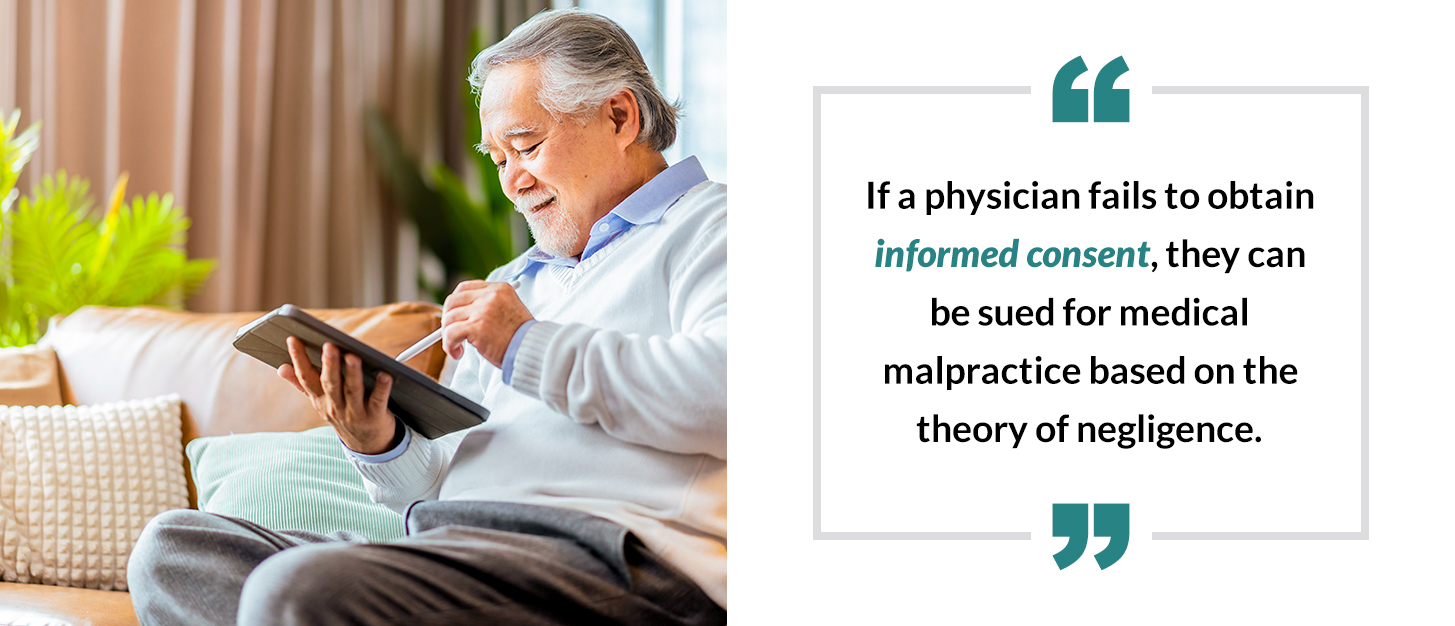The Joint Commission was founded in 1951 with the simple goal of improving the safety and effectiveness of healthcare for the general public. Since then, The Joint Commission has become synonymous with best practices intended to enhance patient safety and the quality of care – such as the process of obtaining patient consent prior to a procedure.
Among the many data points gathered by The Joint Commission is their Sentinel Event database, which tracks patient safety events that resulted in death, permanent harm or severe temporary harm. Between 2010 and 2021, The Joint Commission logged 49 reports of sentinel events related to patient consent such as wrong-site surgeries and post-operative complications. Sadly, if the informed consent process had been done correctly, many of these sentinel events might have been prevented on the patient’s behalf. Likewise, the inevitable legal liabilities that resulted could have been averted by the physician and hospital.
An Attorney’s View of Informed Consent
To learn more about the informed consent process and the many legal considerations related to it, Taylor Healthcare asked Chad Brouillard, M.A., J.D., for his perspectives. Brouillard is a medical malpractice defense attorney, noted healthcare lawyer and adjunct professor at Tufts University School of Medicine. He has written extensively on the topic of health information technology liability. The blog that follows has been condensed from Brouillard’s presentation to Taylor Healthcare in October 2022.
What is Informed Consent?
Many clinicians and providers see informed consent as “just a form” that needs to be filled out prior to a procedure. However, they are failing to understand the importance behind the form.
Informed consent is all about ensuring that shared decision-making occurs between the patient and provider, and that the provider communicates all of the appropriate information to the patient. Done right, it is a win/win for the patient and provider.
- The patient makes a decision about their care while fully understanding the procedure and its related risks, benefits and alternatives.
- The physician is protected against claims that they failed to provide the information necessary for this informed decision to occur.
Providers and hospitals that view informed consent forms as yet another rudimentary task place themselves at risk. If forms are left unsigned by the patient – or are lost by the hospital at a later date – it may create difficulties in proving that consent was truly granted.
Furthermore, medical liability cases related to medical errors typically occur two to three years after the procedure. Providers seeing multiple patients each day may not remember a specific conversation with a specific patient. The form is vital to proving that the conversation occurred and patient consent was obtained.
What Are the Legal Considerations Related to Informed Consent?
Laws and guidelines from states, governing bodies and professional societies (such as the AMA) shape what informed content looks like. At a legal minimum, informed consent forms are necessary for a hospital to achieve accreditation. However, there are many other legal considerations related to informed consent:
Location
Informed consent laws vary by jurisdiction. State regulations can be very murky so it is important to first understand if there are any statutes or guidelines that are in conflict with each other.
Voluntariness
The patient must give their consent voluntarily and without coercion or undue influence.
Competency
The patient must have the mental capacity to understand the information provided and make an informed decision.
Disclosure
The healthcare provider should disclose reasonably material information about the procedure including its risks, benefits and potential alternatives.
Documentation
The informed consent process should be documented in the patient's medical record.
Capacity to revoke
The patient must have the right to revoke their consent at any time.
Right to refuse
The patient must have the right to refuse treatment, even if it is medically necessary.
Age of consent
The age at which a person can legally give informed consent varies by jurisdiction.
Advance directives
Patients may have written instructions that specify their medical treatment preferences in advance.
How Can Physicians Be Held Liable?
A breakdown in the informed consent process opens the provider to many different forms of legal liability. For example:
Negligence
If a physician fails to obtain informed consent, they can be sued for medical malpractice based on the theory of negligence.

Breach of contract
Informed consent can be seen as a contract between the physician and the patient. If the physician breaches this contract, they can be held liable.
Battery
If a physician performs a medical procedure without the patient's informed consent, it might be considered a form of battery and the physician may be held liable for the harm caused.
Fraud
If a physician provides false or misleading information to a patient in order to obtain their consent, they could be held liable for fraud.
Failure to disclose
If a physician fails to disclose important information about a medical procedure, they can be held liable for any harm that results.
Why Are Generic Informed Consent Forms so Problematic?
Generic consent forms make defending a medical malpractice case very difficult for the doctor involved. Even if the form has been signed and retained, there is little information to support the doctor’s assertions. Some of the most common challenges to generic hospital consent forms are as follows.
Lack of information
Generic consent forms typically lack basic information about the nature of the procedure and the risks, benefits and alternatives. Often there are no notations of the specific treatment type on the form. Generally speaking, the more specific the consent form, the more legally defensible it will be.

Lack of shared decision-making
Generic forms, and the lack of specific information noted above, make it difficult to prove that effective patient-provider communication has taken place. Without proof of effective patient-provider communication, there can be no shared decision-making between the patient and provider regarding the procedure in question.
Health literacy
Generic consent forms often display a lack of consideration of the health literacy of the typical patient, as well as a disregard of the varying levels of English-language literacy on the part of patients likely to read the form.
Cultural literacy
The differing cultural issues of patients are rarely considered when developing generic informed consent communication forms and other materials.
What is the Outlook for Informed Consent?
A large shift is happening in healthcare, with patient-centered care becoming very important. Whereas healthcare professionals used to be the primary decision-makers for determining care plans, patients are now at the helm. The informed consent process is at the center of this shift.
A well-executed informed consent process tempers expectations for patients and helps them understand the risks involved with a given procedure. It also helps close the loop regarding follow-up care.
When patients better understand the risks ahead of time – and what the recovery process might look like – they are less likely to pursue medical malpractice claims. Here again, we have a win/win outcome for both the patient and the provider.
[NOTE: The above information was adapted from Chad Brouillard’s presentation to Taylor Healthcare on Oct. 19, 2022.]
Taylor Healthcare: Standardizing and Digitizing Informed Consent
Taylor Healthcare has a special interest in the topic of informed consent. Our iMedConsent™ system eliminates generic paper consent forms of old. Instead, a library of digital consent forms is provided for more than 4,000 treatments in 37 clinical specialties. Patients are able to review these digital consent forms with their personal mobile devices and then provide signatures electronically. The signed documents are stored automatically in the EHR or patient portal.
To learn more about iMedConsent, contact your Taylor Healthcare representative.






.png)



